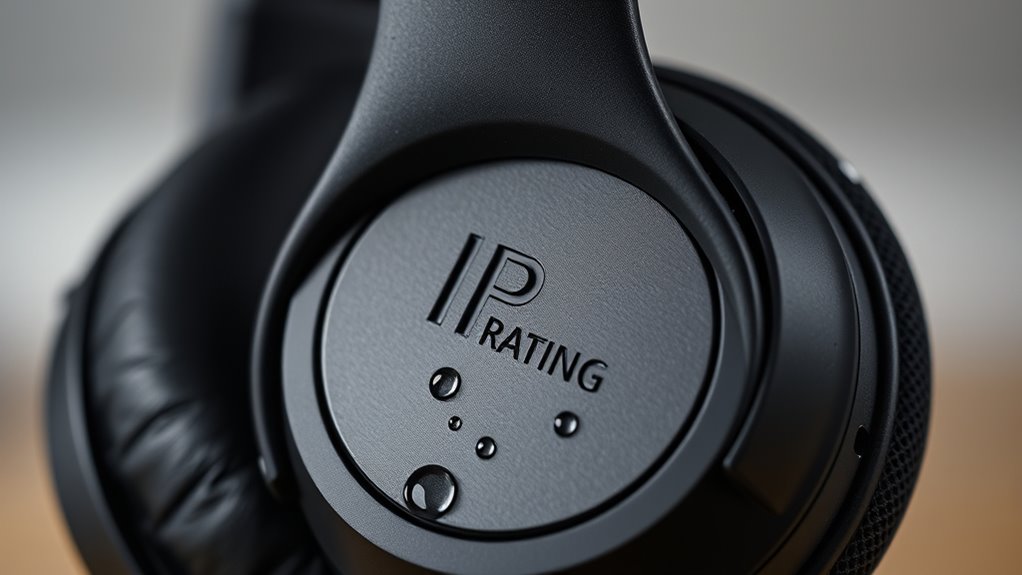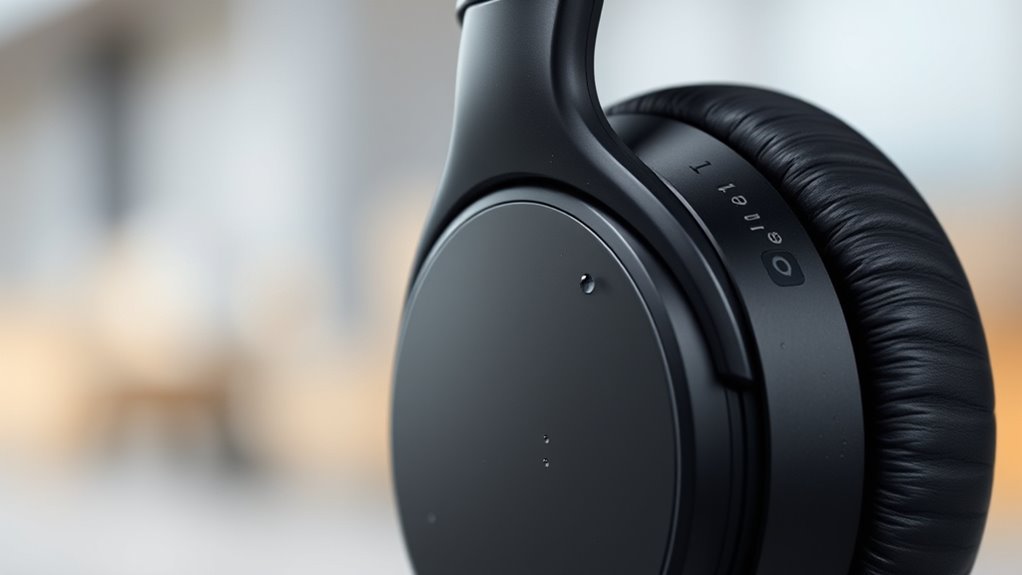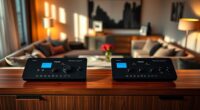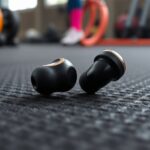Understanding IP ratings helps you know how well your headphones resist dust and water. The first digit shows protection against dust, with higher numbers meaning better dust resistance, while the second digit indicates water resistance, varying from splashes to full submersion. Knowing these details lets you pick headphones suitable for outdoor or active use, ensuring durability against daily wear and tear. If you want to find out more about these ratings, there’s plenty more to discover.
Key Takeaways
- IP ratings specify a device’s protection level against dust (first digit) and water (second digit), helping assess durability.
- A higher first digit (4-6) indicates better dust resistance, essential for dusty environments or outdoor use.
- The second digit describes water resistance, with higher numbers (e.g., 7, 8) allowing immersion or protection against splashes.
- Understanding IP ratings ensures headphones are suitable for specific activities like workouts or outdoor adventures.
- Always verify manufacturer details to confirm the precise water and dust resistance capabilities of headphones.

Have you ever wondered what those numbers and letters on your electronic devices mean when it comes to protection against dust and water? If so, you’re not alone. Many people see the IP rating—like IP68 or IP54—and don’t fully understand what it signifies. These ratings are essential because they tell you how well your device can handle exposure to elements like dust and water, especially for gadgets like headphones that you might want to use outdoors or during activities where exposure is inevitable. Understanding IP ratings helps you pick the right headphones for your lifestyle, ensuring they’ll withstand daily wear and tear without damage.
The first part of the IP rating, represented by the first digit, indicates dust protection. If you see a number like 4 or higher, it means your headphones can resist a certain amount of dust. For example, a rating of IP54 means your device is protected against dust that could interfere with its operation but isn’t completely dust-tight. If you want maximum dust protection, look for ratings like IP6X, which guarantees total dust ingress protection. This is especially important if you plan to use your headphones in dusty environments like construction sites or during outdoor activities where dust particles are common. Dust can clog up small openings or damage internal components, so a high dust protection rating gives you peace of mind.
The second digit in the IP rating, which follows the letter IP, indicates water resistance. If you see a number like 5 or 6, it shows how well the device can handle water exposure. A rating of IPX7, for example, means your headphones can be submerged in water up to one meter deep for 30 minutes without damage. This is useful if you want headphones that can handle splashes or accidental spills, or even use them while jogging in the rain. Higher water resistance ratings like IPX8 mean the device can withstand prolonged immersion, but always check the manufacturer’s specifications to understand the exact limits. Water resistance in headphones isn’t just about avoiding damage; it also affects how you can use them in different environments without worry.
Additionally, the testing standards for IP ratings ensure consistent and reliable assessments of a device’s durability, helping consumers make informed choices based on real-world conditions. Ultimately, understanding IP ratings helps you make smarter choices about your headphones. Whether you need dust protection for outdoor adventures or water resistance for workouts, the right rating ensures durability and functionality. Keep an eye on those numbers—because they’re your best guide to knowing how resilient your headphones are against the elements.
Frequently Asked Questions
Can IP Ratings Change Over Time With Wear and Tear?
Yes, IP ratings can change over time due to wear and tear. As your headphones experience everyday use, their durability can degrade, especially if they’re exposed to harsh conditions or rough handling. This wear and tear might create small damages or weaken seals, reducing their water and dust resistance. Over time, your headphones may no longer meet their original IP rating, so maintaining awareness of their condition is crucial to preserve protection.
Are Higher IP Ratings Always Better for Everyday Use?
Higher IP ratings aren’t always better for everyday use, but they do offer better water resistance and dust protection. If you often listen outdoors or near water, a higher rating helps keep your headphones safe. However, for casual use, a lower rating might be enough. Keep in mind, wear and tear can affect these ratings over time, so choose based on your environment and how much protection you need.
Do IP Ratings Apply to Headphone Microphones and Cables?
IP ratings do apply to headphone microphones and cables, but not always explicitly. They indicate microphone durability and cable protection from water and dust, so higher ratings mean better resistance. If you often use headphones outdoors or in dusty environments, look for models with suitable IP ratings to guarantee your microphone stays clear and cables stay intact. Remember, not all cables and microphones have IP ratings, so check specifications carefully.
How Do IP Ratings Compare Between Different Headphone Brands?
Think of comparing IP ratings between headphone brands like choosing a car with solid safety features. Some brands, like Bose or Sony, prioritize rigorous testing standards and have higher IP ratings, ensuring better water and dust resistance, boosting their reputation for durability. Others might have lower ratings, so it’s wise to check each brand’s specific testing standards before buying. Your choice depends on how much you value longevity and brand reliability.
Can I Upgrade My Headphones’ Water Resistance After Purchase?
You can’t upgrade your headphones’ water resistance after purchase because the waterproof casing isn’t designed for modifications. These casings are tested through durability testing to meet specific IP ratings, ensuring water and dust resistance. Attempting to alter or add to the casing could compromise its integrity, risking damage. If you need higher water resistance, consider purchasing headphones with a higher IP rating from the start.
Conclusion
Think of IP ratings as your headphones’ armor in a world full of surprises. Just like a trusty shield keeps you safe from rain or dust on a wild adventure, these ratings tell you how well your headphones can handle the elements. So, next time you choose a pair, remember it’s not just about sound—it’s about having a reliable guardian that keeps going, rain or shine, dust or splash. Stay protected, stay connected.
Carl is the author of 1home Theatre Projector. When he’s not busy writing about all things projector-related, you can find him playing basketball or watching a good movie. He knows that jumping to a projector-based home cinema can be daunting, but he’s here to help make it as easy as possible. With his comprehensive guides and product reviews, you’ll be able to find the right projector for your needs and set it up in no time. Plus, he’s always on top of the latest news and information on upcoming releases, so you’ll always be ahead of the curve.
















